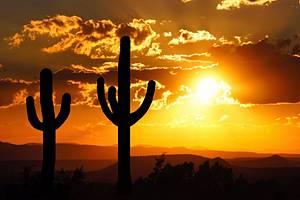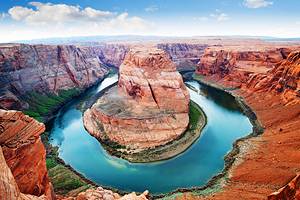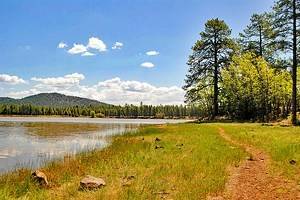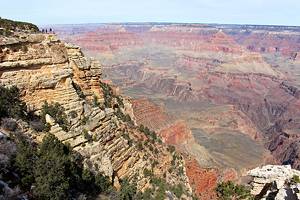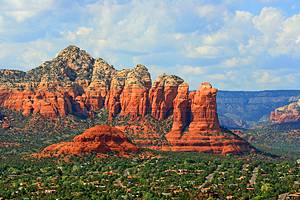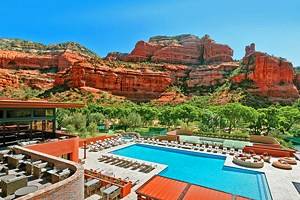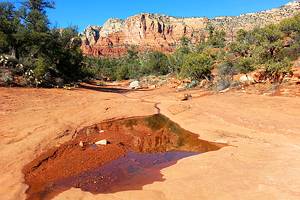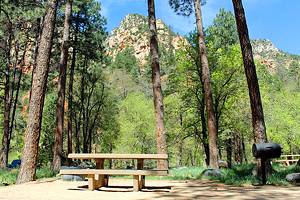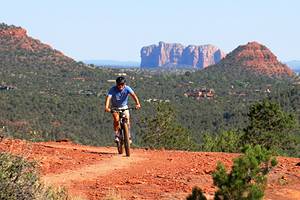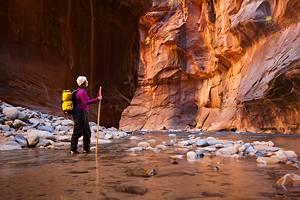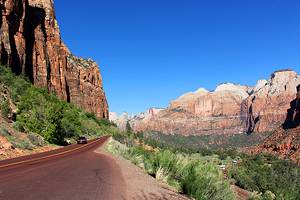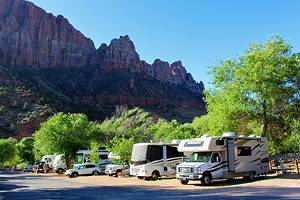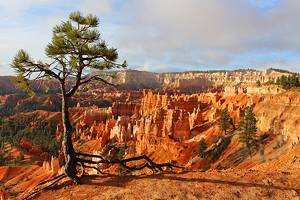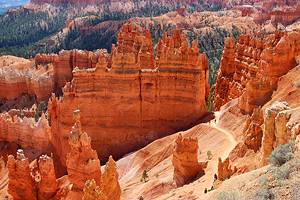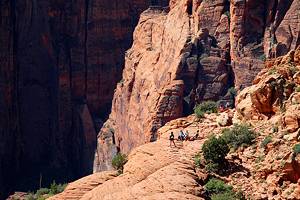Hiking Trails at the Grand Canyon
Scenic hiking trails line the Grand Canyon from its rims to the Colorado River. This includes great day hikes and backpacking routes on the North and South Rim of this century-old national park.
The hiking selection ranges from easy hikes overlooking a beautiful view to more rugged trekking options that descend into the canyon. And one common aspect of all walking trails in the Grand Canyon is panoramic grandeur.
Most hiking trails at Grand Canyon National Park navigate at least some challenging terrain. During the summer season, visitors should avoid physical activity after 10am and throughout the heat of the day. Drinking plenty of water, wearing appropriate clothing, and checking in at the visitor center is recommended upon any visit–as well as watching your step when walking close to the edge.
For day hikers, what goes down must come up, which can be quite the challenge when climbing out of the Grand Canyon. For backpacking into the Grand Canyon, including trekking options on the Bright Angel, South Kaibab, and North Kaibab Trails, the park's Backcountry Information Center is a good resource for trip planning.
Other special Grand Canyon experiences like mule rides, guided hikes, and special permitted waterfall hikes are facilitated by the national park or within communities like Tusayan just outside the gates.
Explore this famous attraction with our list of the top hiking trails at the Grand Canyon.
South Rim Trail
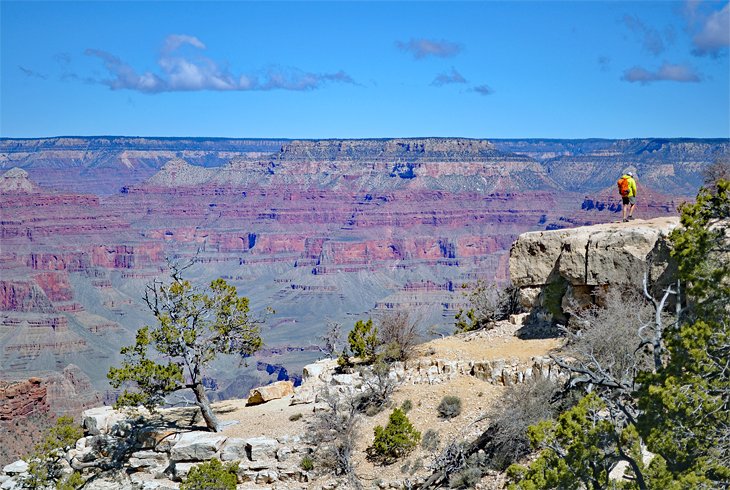
For many visitors, the South Rim Trail is where they first lay eyes on the Grand Canyon. It's an experience not easily forgotten, and the viewpoints are plenty.
This 13-mile paved route has minimal elevation change, but you can make this as long or short of a hike as you like. Shuttle stops line the route, connecting scenic viewpoints with park facilities like the Grand Canyon Visitor Center. interpretive information is displayed along the way.
Iconic lookouts and Arizona photo opportunities are seen from places like Mather Point and Powell Point along the South Rim Trail, and Yavapai Point is one of the best to catch a sunset. The ease of access to these viewpoints can lead to crowded conditions, especially throughout the summer.
Other nearby facilities include the Market Plaza and Mather Campground, and hikers on the South Rim Trail can access every South Rim trailhead that navigates into the canyon. This selection of canyon hikes includes the popular Bright Angel Trail and South Kaibab Trail. Caution needs to be applied while exploring and photographing next to the steep cliffs of the South Rim Trail.
Bright Angel Trail
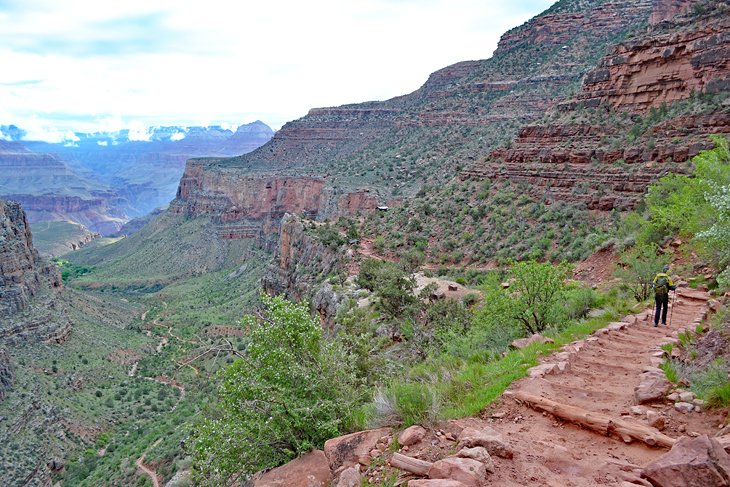
The Bright Angel Trail is an iconic hiking trail of America. It descends steeply from the South Rim of the Grand Canyon, revealing fantastic views that cannot be experienced from the rim. The trail encompasses endless switchbacks and unfolding views as it descends over 4,000 feet in nine miles, spanning the South Rim to the Colorado River.
Hiking back up can easily take twice as long as hiking into the Grand Canyon. It's highly encouraged for day hikers to trek only partway down the trail. Two aptly named Rest Houses along the Bright Angel Trail make for great turnaround points on day hikes. The Mile-and-a-Half Rest House and Three-Mile Rest House both provide seasonal water and composting toilets.
Pack mules carry tourists and supplies up and down the Bright Angel Trail daily, and hikers should follow all instructions of the pack leader when encountering a mule line.
The Bright Angel Trail is a popular trail for backpacking and long-distance hiking through the Grand Canyon corridor. It's often used as the uphill route, thanks to the seasonal water sources available.
Backcountry camping is available along the Bright Angel Trail at Indian Gardens and Bright Angel Campground, and unique overnight lodging at the bottom of the Grand Canyon is hosted by Phantom Ranch (permits and reservations required.)
South Kaibab Trail
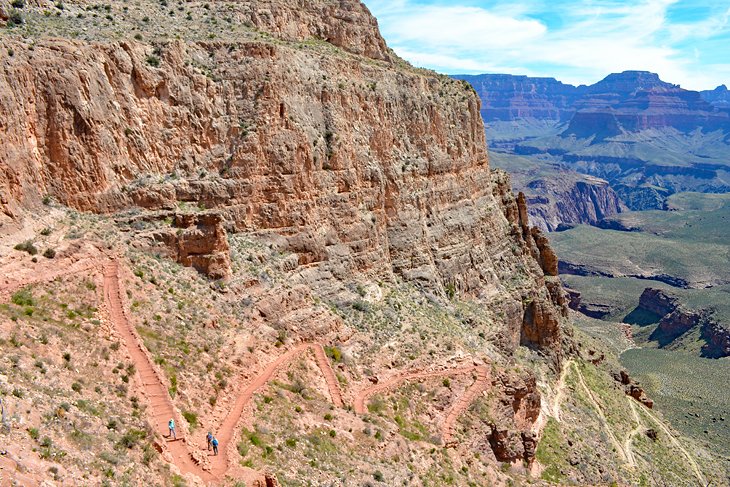
No personal vehicles are allowed at the South Kaibab Trailhead, one of the most popular into-the-canyon hikes on the South Rim. Instead, a convenient shuttle system transports hikers to and from the trailhead throughout the day, including early morning.
And an early morning start is recommended for anyone looking to experience the length of this iconic hiking trail and marvel of trail engineering. The trail drops nearly 5,000 feet in seven miles between the South Rim and the Colorado River. No water sources are available, and much of the route is exposed to the sun and radiating rock formations.
Don't let the challenges dissuade day hiking the South Kaibab, though, as the route displays stunning views of the expansive canyon not seen from the rim. For day hiking, places like Ooh-Aah-Point (one mile down) or Cedar Ridge (1.5 miles), are good turnaround points, as is Skeleton Point (three miles), which includes the first views of the Colorado River.
The switchbacking South Kaibab Trail is a common trailhead to start a backpacking trip into the Grand Canyon. Its quick elevation change tends to be more favorable as a downhill trek.
Bright Angel Point Trail
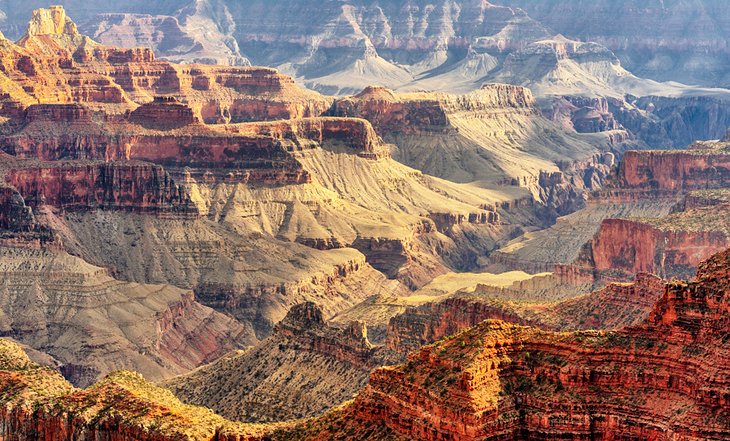
Bright Angel Point is a standard excursion on any visit to the North Rim. It provides an accessible half-mile trail leading to arguably the best views of the canyon. The hike departs from the Visitor Center and Lodge on the North Rim and is a great introductory trail to do the moment you get out of the car.
Interpretive information is available along the way and at the visitor center, and as the main outlook on the North Rim, this trail is typically shared by other hikers admiring the jaw-dropping views.
North Kaibab Trail
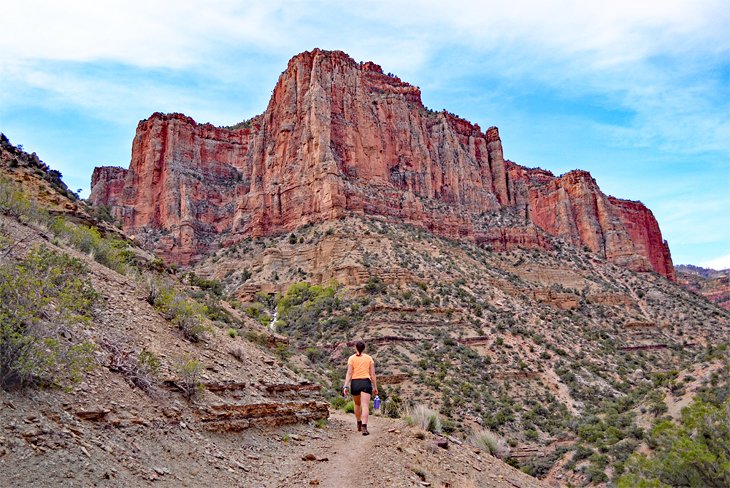
The North Kaibab Trail was constructed in the 1920s and is the only maintained hiking path that enters the canyon from the North Rim. Like the South Kaibab and Bright Angel Trails, the North Kaibab Trail steeply switchbacks all the way down to the Colorado River.
For day hikes on the North Kaibab Trail, rather than the demanding 14 miles down to the river and back up, it's highly advisable to use one of many scenic turnaround points along the way. At 1.7 miles, the North Kaibab Trail goes under the impressively blasted Supai Tunnel, and three miles after that, Roaring Springs, the source of all drinking water in the park, is often a preferred place to start hiking back up to the rim.
Potable water is seasonally available at the Manzanita Rest Area, 5.4 miles down the North Kaibab, and the trail passes by Cottonwood Campground 1.4 miles later. This backcountry campground is the closest within the canyon to the North Rim, and permits are required to spend the night.
Some would argue that the best views of the Grand Canyon are uncovered on the way down the North Kaibab Trail, and with far less traffic than its southern counterparts, it certainly provides more solitude.
After entering the inner gorge and connecting with Phantom Ranch, the North Kaibab reaches the Colorado River at 14 miles and intersects with the South Kaibab and Bright Angel Trails.
Havasu Falls
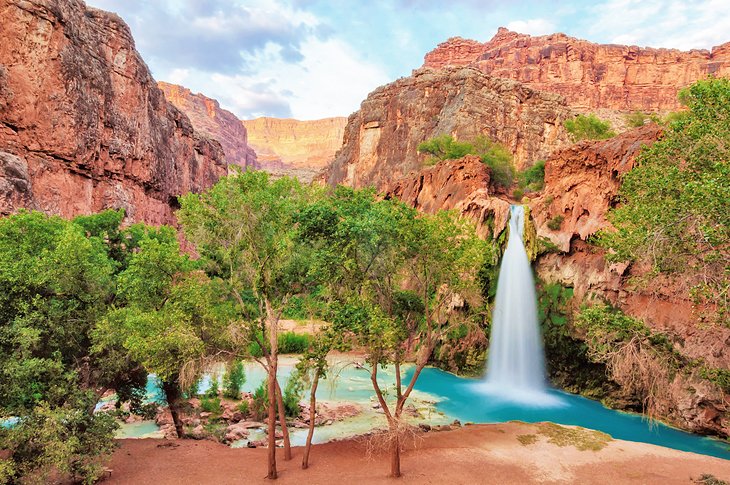
One of the most famous waterfall hikes in the nation, let alone the Grand Canyon, the blue waters of Havasu Falls have been mesmerizing visitors and residents for eons. The trail is located on the Havasupai Indian Reservation, and highly competitive permits are needed to hike to this special water feature and the surrounding idyllic area in the Grand Canyon.
This is at least a 10-mile, moderately strenuous hike. Day hiking is not allowed to Havasu Falls, rather overnight backpacking or mule riding is required to see the waterfalls.
Official Site: http://theofficialhavasupaitribe.com/
Grandview Trail

The Grandview Trail is a route first scratched out by copper miners and their mules. Today, it's a steep, South Rim hiking trail that avoids the crowds of the nearby Bright Angel and South Kaibab. Grandview Trail is also a viable backpacking route with a generally easier permit to secure.
Popular camping spots on the Grandview Trail are situated atop Horseshoe Mesa among many historical mining remnants. Horseshoe Mesa also makes for an excellent turnaround point for day hikes. It's an approximately six-mile hike to Horseshoe Mesa and back, with nearly 3,000 feet of elevation change. It's not a hike to underestimate, especially hiking back up.
Parking is available at the Grandview Trailhead, located between the Grand Canyon Village and Desert View Campground.
Widforss Trail
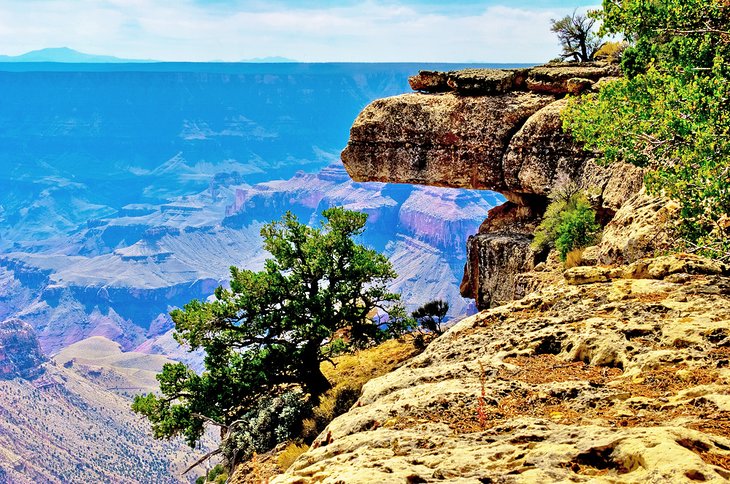
On the North Rim, this scenic trail is named after Gunnar Widforss, an early 20th-century artist renowned for his water colorings of the Grand Canyon.
The Widforss Trail follows the North Rim for over two miles to start and provides breathtaking panoramas of this quieter side of the canyon. The trail then navigates into a shaded forest punctuated with the occasional remnants of past fires in the area.
After approximately five miles total, the trail emerges out of the forest and back to canyon views at Widforss Point.
Cape Final Trail
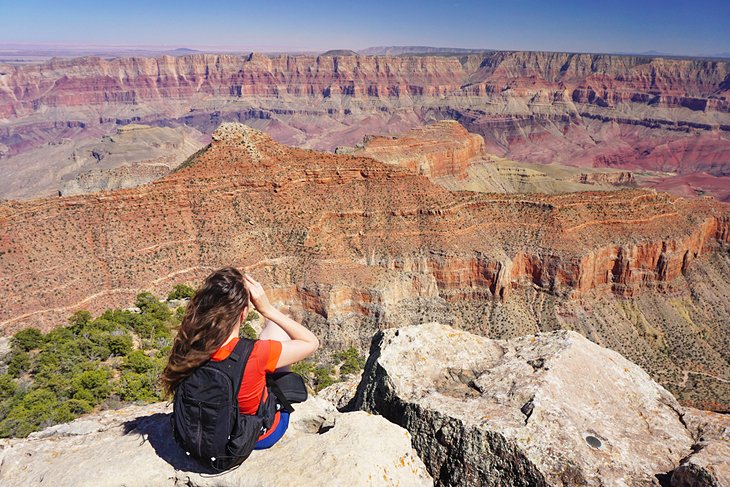
The Cape Final Trail is a four-mile hike on the North Rim, with stunning views, a moderately level trail, and often little crowds. The trail navigates through the forest and along the canyon's edge and ultimately leads to a stunning viewpoint from Cape Final.
Many prominent features of the Grand Canyon are viewed from this precipice, including the Vishnu Temple and the eastern edge of the Canyon. With only moderate elevation change, Cape Final Trail is a good family-friendly hike on the North Rim.
Hermit Trail
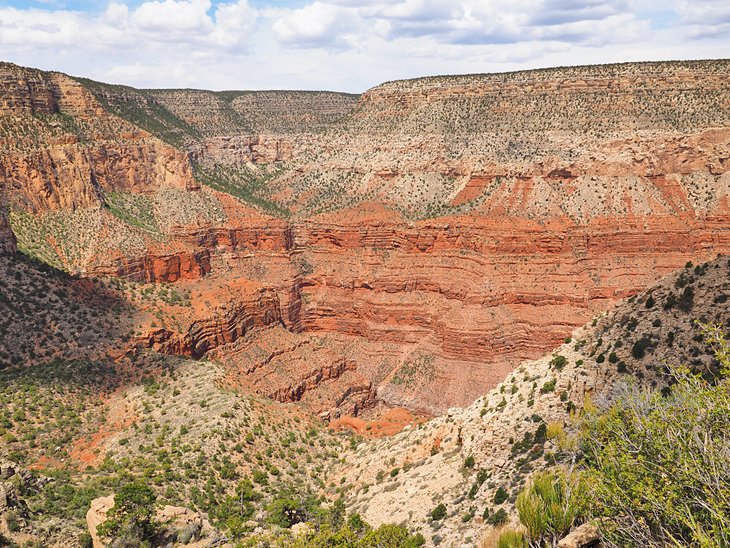
The Hermit Trail is an alternative rim-to-river-hiking trail on the South Rim, on the western edge of the park, providing a more solitary canyon experience.
The trail drops 2,000 feet within the first 2.5 miles, making for a tough route going back up. It should be attempted by practiced desert travelers only.
This was once the main thoroughfare into the Grand Canyon during the early years of the park, and only a few permitted campsites are available on the Hermit Trail today, leaving much of the foot traffic belonging to day hikers.
At 2.5 miles beneath the rim, Santa Maria Springs is often a turnaround point on the Hermit Trail. Water is available at Santa Maria Springs, though it needs to be treated before consumption.
The Hermit Trail also connects with the Tonto Trail, an important inner canyon route that runs across the Canyon on the Tonto Platform.
Rim-to-Rim Trail
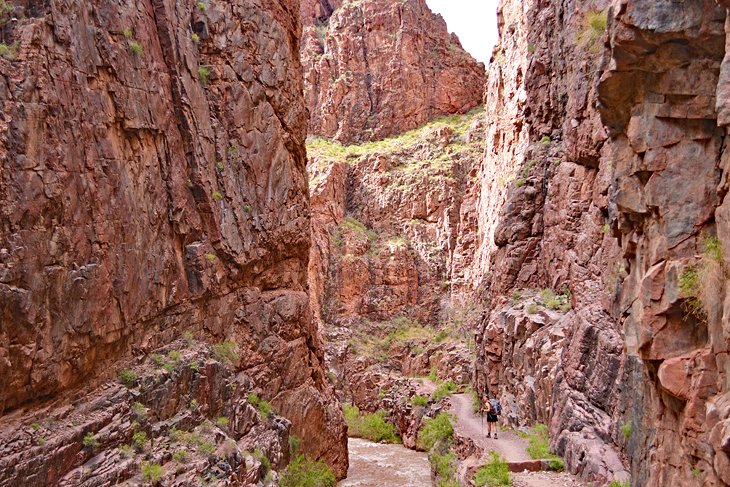
For those who want to hike the Grand Canyon in a day, the Rim-to-Rim Trail presents a classic adventure challenge.
Hiking the 24 miles of trail that connects the North and South Rim of the Grand Canyon, including at least 4,500-plus feet of elevation gain, should be attempted only by experienced long-distance hikers. Early starts before daybreak are nearly mandatory to accomplish the Rim-to-Rim hike in a day. Interested individuals should contact the Backcountry Information Center for more information.
A common route for hiking Rim-to-Rim begins at the South Kaibab Trailhead. After descending the waterless route to the river, hikers pass Phantom Ranch and connect with the North Kaibab Trail that ascends to the North Rim.
How to get back to where you started is a logistic to figure out when attempting the Rim-to-Rim, with either a lengthy shuttle ride seasonally available (May-October) as an option, or a Rim-to-Rim-to-Rim hike to get back to your car.
Rim-to-Rim-to-Rim Trail
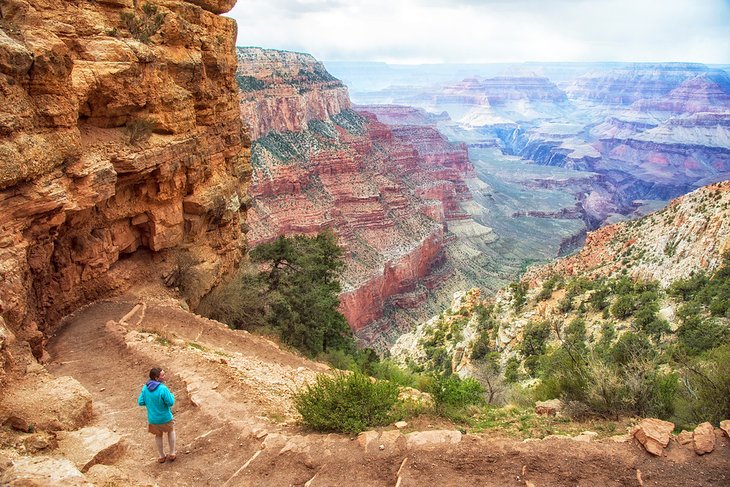
The Rim-to-Rim-to-Rim Trail is the ultimate adventure hike in the Grand Canyon.
The route follows the same general direction as the Rim-to-Rim hike noted above, but it avoids the need for a shuttle by turning around and repeating the 24-mile hike over again.
Any Rim-to-Rim hike is possible over two days or more with a backcountry permit. The Bright Angel Campground is near the Colorado River in the middle of the route, catering to those willing to carry their gear. Additional backcountry campgrounds are on the Bright Angel Trail and North Kaibab Trail. A backcountry permit is required to spend the night at these primitive campgrounds within the park.
This near 50-mile endeavor is only possible in a day by running at least some of the route. Only trained long-distance runners should attempt the Rim-to-Rim-to-Rim hike in a single day. The season to tackle this impressive hiking feat spans from May to October. The shoulder months provide cooler temperatures at the base of the Grand Canyon, but less daylight to accomplish the goal. A start before daybreak is required, and athletes should expect to finish in the dark. Be sure to bring along a reliable source of light.
Visitors attempting either the 24-mile Rim-to-Rim or the 48-mile Rim-to-Rim-to-Rim should consult with park staff before taking off to ensure someone knows the group's planned itinerary.
Map of Hiking Trails at the Grand Canyon
Grand Canyon, AZ - Climate Chart
| Average minimum and maximum temperatures for Grand Canyon, AZ in °C | |||||||||||
| J | F | M | A | M | J | J | A | S | O | N | D |
| 7 -8 | 8 -7 | 11 -4 | 16 -2 | 21 2 | 27 6 | 29 10 | 27 9 | 24 6 | 18 1 | 11 -4 | 7 -8 |
| PlanetWare.com | |||||||||||
| Average monthly precipitation totals for Grand Canyon, AZ in mm. | |||||||||||
| 40 | 42 | 50 | 27 | 16 | 12 | 50 | 52 | 36 | 34 | 33 | 28 |
| Average minimum and maximum temperatures for Grand Canyon, AZ in °F | |||||||||||
| J | F | M | A | M | J | J | A | S | O | N | D |
| 44 17 | 47 20 | 52 24 | 60 28 | 70 35 | 81 42 | 84 50 | 81 49 | 75 43 | 64 33 | 52 24 | 45 18 |
| PlanetWare.com | |||||||||||
| Average monthly precipitation totals for Grand Canyon, AZ in inches. | |||||||||||
| 1.6 | 1.7 | 2.0 | 1.1 | 0.6 | 0.5 | 2.0 | 2.0 | 1.4 | 1.4 | 1.3 | 1.1 |
More Related Articles on PlanetWare.com
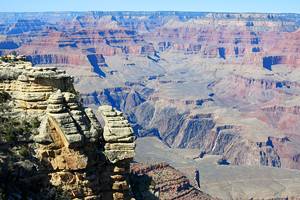
Grand Canyon Accommodation and Attractions: The Grand Canyon is in a relatively remote part of Arizona, leaving the logistics of where to stay often something to contend with. To get the full experience of the Grand Canyon, our Attractions on the South Rim article can point you towards tour packages, camping options, and more unique opportunities to experience the Grand Canyon.
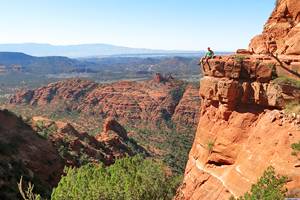
More Arizona Hikes: For extra exploring in the state of Arizona, the best hiking trails in Arizona include many other scenic destinations that will make you want to stay awhile. For more red rocks and awesome hiking trails, the hiking trails in Sedona add extra miles to an Arizona adventure.


